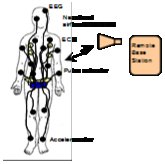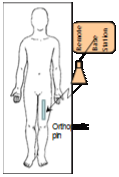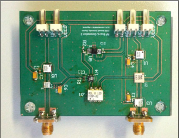

|
Dr. Karmakar is the recipients of prestigious Australian Research Council (ARC) Discovery Project and ARC Linkage Project grants. Followings are a few research projects supervised by Dr. Karmakar in recent years. Prospective students are welcome to work on these projects. |
|
Research projects |

|
Last Updated February 2017 |

|
Improved antenna will be developed to improve the capacity and the coverage of wireless communications for rural and regional Australia. |
|
ARC Linkage Project: Improved Wireless Communications for Rural and Regional Australia ($73,950 for ‘06-’09) |
|
Phased arrays are very expensive. A low cost planar phased array antenna is developed for affordable mobile satellite communications for the scratch. |
|
Phase Array for Satellite Communications |


|
12-element circular phased array and beam-forming network |
|
The active RFID tag reader with microprocessor, display and RF electronics is developed. The reader is capable to cull frequency signatures from a chipless RFID tag. |
|
ARC Discovery Project: Chipless RFID Reader on Conveyer Belt |
|
A wireless physiological monitoring apparatus connectable to a patient with sleeping disorder is developed. The apparatus comprises a biological transducer, transceiving antenna, modulator and a microcontroller. |
|
ARC Linkage Project: Radio Frequency Wireless Monitoring in Sleep Apnoea |
|
Wireless eBio- polysomnography transducer arrangement |
|
The active RFID tag without microprocessor chip will be developed for polymer banknotes. The project will investigate the reader and the tag system for billions of banknote denominations in Australia and overseas |
|
ARC Linkage Project: Printable Multi-Bit Radio Frequency Identification for Banknotes ($895,000 for 2009-11) |
|
Smart antenna will be developed to detect partial discharge from faulty power apparatuses without human intervention. |
|
ARC Linkage Project: Smart Information Management of Partial Discharge in Switchyards using Smart Antennas ($454,000 for 2009-11) |
|
A back-scattered based chipless RFID tag and reader system comprised on multiple antennas (MIMO) capable of reading uniquely multiple book in automatic check out kiosk and bookshelves will revolutionized the library information management system. |
|
ARC Linkage Project: Back-scatter based RFID system capable of reading multiple chipless tags for regional and suburban libraries ($585,000 from ARC) |
|
An electronically controlled orthopedic pin wirelessly controlled by a base station will remove the painful surgical process and human intervention. It will revolutionized the bone healing and growth therapy. |
|
Wireless Battery Operated Orthopaedic Pin for Bone Healing and Growth Therapy for Children |


|
Chipless Tag |



|
Collinear antenna |

|
Printable chipless RFID tag |
|
FPGA controlled phased array RFID reader antenna to improve the efficacy of reading RFID tags. Multi-disciplinary project encompasses both physical layer and digital control designs. |
|
ARC Discovery Project: Electronically controlled phased array antenna for (RFID) applications ($275,000 for 2011-2013) |
|
A microwave vest is designed with switched beam broadband antenna array for imaging of paediatric cancer patients |
|
Microwave Medical Devices for Imaging of Pediatric Cancer Patients (ICT Geelong Innovation Test Runner Up 2010 ) |






|
Photo: Reader RF Section (left) & reader on conveyer belt |

|
Open day demonstration of RF Partial Discharge Probe in 2011 |

|
2011 Monash Open day demonstration of mm-wave chipless tag (Hamza to a visitor) |

|
Uditha is assembling phase shifter behind a 64-element UHF phased array antenna |

|
Dr. Emran is assembling data-cable for a 64-element UHF phased array antenna |

|
Dr. Azad is testing switching electronics for a 64-element UHF phased array antenna |

|
Dr. karmakar is testing an RFID reader antenna |

|
A mm-wave chipless tag |
|
DEPARTMENT OF ELECTRICAL & COMPUTER SYSTEMS ENGINEERING |

|
A Ku/Ka-band active phase shifter is designed 018 mm and 90 nm GaAs or GaN fabrication processes. In collaboration with Prof. Chiu, CGU, Taiwan, the project has international collaboration and student exchange opportunities. (2 PhD students) |
|
Lightwave Fidelity (LiFi) is an emerging visible light communication (VLC) with M/Gbps data transmission rate. The project develops: (i) An operating prototype for LiFi system that enables high speed data communication; (ii) A LED RGB prototype that is capable of submitting data signal speeds at a higher ratio to that of existing RGB LED’s; and (iii) A hybrid LiFi network that operates alongside complimenting a WiFi network (3 PhDs) |


|
Vehicles are the most Co2 emitters and damage our environment and health. A wireless power transmission and on-board reception system is built to charging the battery of a vehicle on the move. The low-cost on board smart antenna scavenges Kwatts of power from power line. The transducer on the power line coverts 50 Hz HV power into 2.45 GHz microwave energy and transmits toward the vehicles. (1 PhD student) |
|
Customers can get excellent shopping experience is an RFID system based cloud computing interface is possible to installed. A chipless RFID enabled smart shopping trolley is proposed. The trolley is retrofitted with a chipless RFID tag reader. The items tagged with fully printable chipless RFID tag are scanned with the reader and recorded in the electronic list. The payment will be automated with cloud computing interfaced with the central database. (5 PhD students) |


|
Direct Sequence Code Division Multiple Access (CDMA) cellular radio systems employing different array configurations with eigenbeamforming in multipath environments are analyzed with a uniform linear array and a circular array. the simulation results indicate a significant increase in system capacity. |

|
Smart antenna beam-forming |
|
Smart Antennas for Mobile Communications |
|
Low cost fully printable plastic RFID tag in CPW format offer more than 23 bits in UWB frequency spectrum |
|
ARC Discovery Project: Chipless RFID for Barcode Replacement ($392,000 for ‘06-’09) |

|
60 GHz chipless RFID tag is equivalent to a electromagnetic (EM) barcode. It uses synthetic aperture radar (SAR) and massive Multiple input multiple output (MIMO) to process the signal and reduce reader hardware requirement. PARC, Xerox, USA, is collaborating in this technology to enhance their high resolution printing capacity. (1 PhD student) |


|
60 GHz EM barcodes are tiny EM particles that reflects EM energy with specific radar cross section (RCS) levels when illuminated with a 60 GHz reader antenna (DSPD). SAR imaging technique synthesises the image of the tag like optical barcodes (1 PhD student) |

|
Low cost fully printable chipless RFID is a potential solutions for Internet of Things (IoT) and precision agriculture for both developing and developed worlds. In this project, the chipless RFID sensor developed for multiple physical parameters monitoring is applied to IoT and precision agriculture. A sink/hub collects physical data such as soil moisture, salinity, pH, and sends the data via wifi and cloud computing to the farmhouse for data interpretation and analysis of plant health. The low-cost sensors pave the way for precision agriculture for tomorrow’s farming. |

|
MMARS has extended its chipless RFID tag from identification to sensing capability using smart/function materials. In collaboration with Monash University Material Engineering researcher, MMARS has developed relative humidity (above photo), temperature, impact/crack and pH sensors. The sensors are fully printable and therefore, has the prospects to be printed on paper or plastic substrates as roll to roll printing format. MMARS also developed a temperature memory sensor with a potential to cater for the needs of biotech industry. (1 PhD student) |





|
Surface integrated waveguide (SIW) is a planar transmission line that exploits the advantages of waveguides but overcomes the limitations of the quasi-TEM modes in microstrip lines. A Ka\Ku-band phased array antenna is developed for radiometer applications. The phase shifter bank controls the excitation phases of the SIW slot arrays to control the beam. (1 PhD student) |
|
Low-cost printing methods for microwave/mm-wave circuits are life blood of sub-cent chipless RFID tag development. MMARS has developed its in-house facilities to print fully printable chipless RFID tags on paper and plastic substrates. The above photograph shows a screen printed chipless RFID tag resonator. The graph shows the similated and measured results of a 9-bit chipless RFID tag. (1 PDF/1PhD student) |






|
A mm-wave chipless tag reader transceiver section |

|
A mm-wave chipless tag reader digital control and power supply unit |

|
A mm-wave chipless tag reader transceiver section on PCB |